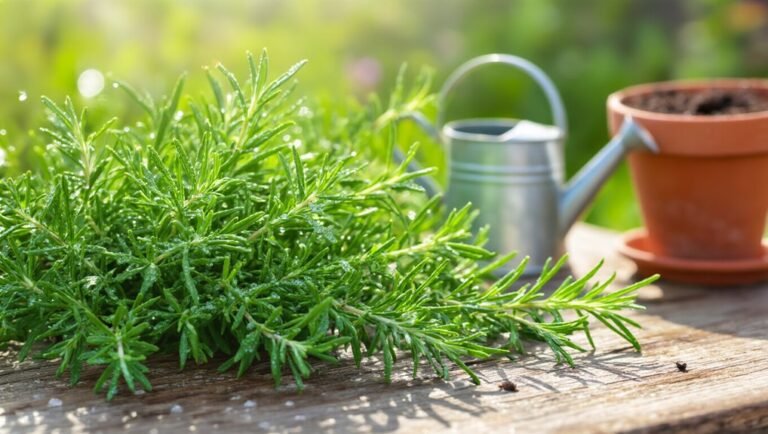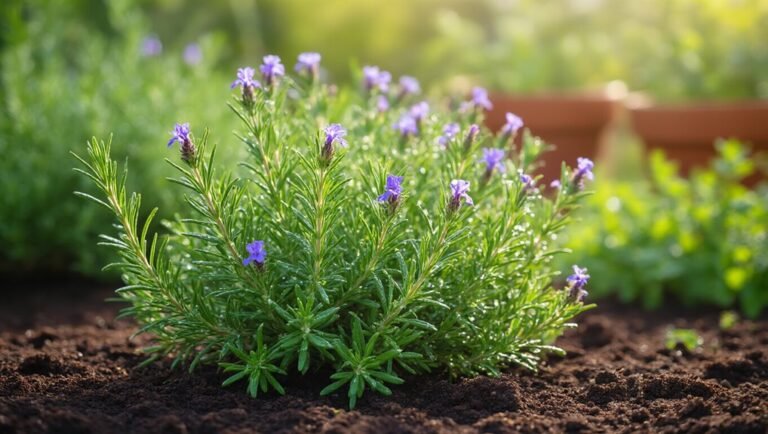To grow rosemary easily in your garden, pick a variety like ‘Tuscan Blue’ for flavor or ‘Prostratus’ for aesthetics. Ensure it gets 6-8 hours of sun and plant it in well-draining, sandy soil. Water sparingly, allowing the soil to dry between waterings, and use a balanced fertilizer to promote growth. Regularly check for pests and diseases, and don’t forget to prune. You’ll discover more tips and techniques to make your rosemary thrive as you explore further.
Key Takeaways
- Choose a suitable variety of rosemary, such as ‘Tuscan Blue’ for culinary use or ‘Prostratus’ for ornamental purposes.
- Ensure full sun exposure with 6-8 hours of direct sunlight and well-draining soil for optimal growth.
- Water sparingly, allowing the top inch of soil to dry out between waterings to prevent root rot.
- Monitor for pests like aphids and spider mites, and treat with organic solutions as needed.
- Harvest in the morning using clean shears, and avoid overharvesting to promote healthy plant growth.
Choosing the Right Variety of Rosemary

When it comes to choosing the right variety of rosemary, you’ll find several options that can suit your garden’s needs.
Consider the popular ‘Tuscan Blue,’ known for its vibrant blue flowers and strong flavor, perfect for culinary use. If you’re looking for a compact option, ‘Blue Boy’ fits well in smaller spaces while still providing a lovely aroma. For gardeners who want a head start, using seed starting kits can help ensure successful germination and healthy young plants.
For ornamental purposes, ‘Prostratus’ offers beautiful trailing growth, great for hanging baskets or ground cover. Don’t forget about ‘Arp,’ which boasts cold-hardiness, making it suitable for cooler climates.
Think about how you plan to use rosemary—culinary, ornamental, or both—as this will guide your decision. Choose a variety that aligns with your garden vision and enjoy its many benefits! You can also start your rosemary journey with a convenient herb garden kit that includes seeds and pots, making it easy to grow your own herbs at home.
Ideal Growing Conditions for Rosemary
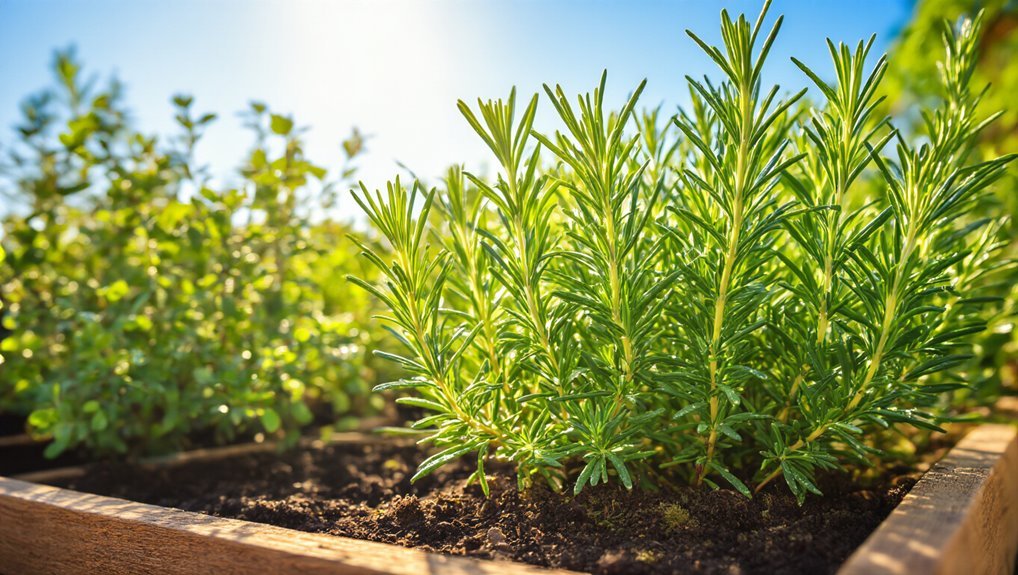
Selecting the right variety of rosemary is just the beginning; understanding its ideal growing conditions is key to thriving plants.
To grow healthy rosemary, keep these conditions in mind:
- Sunlight: Rosemary loves full sun, so aim for at least 6-8 hours of direct sunlight daily.
- Soil: Well-draining soil is essential. Avoid heavy, compacted soils that retain water.
- Temperature: It thrives in warm weather, ideally between 65°F and 75°F (18°C to 24°C). Protect it from frost.
- Watering: Water sparingly. Let the soil dry out between waterings to prevent root rot. For gardeners aiming to provide balanced nutrition, consider enriching your soil with plant fertilizer tablets for improved rosemary health.
For gardeners looking to boost soil health or manage nutrients effectively, using fertilizer spreaders can help ensure even distribution of amendments for optimal rosemary growth.
Preparing the Soil for Planting
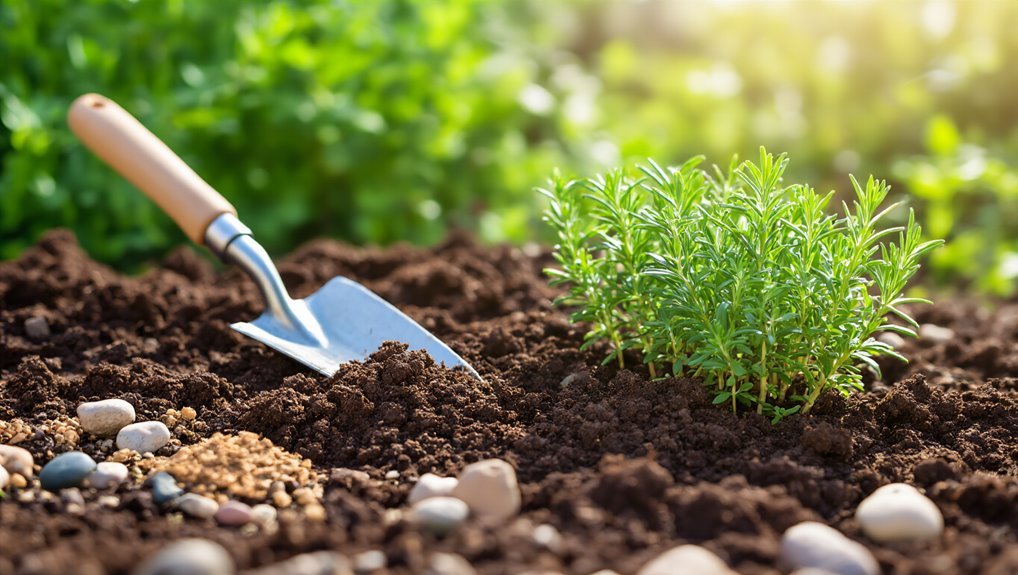
Before you plant your rosemary, it’s crucial to prepare the soil properly to ensure strong growth.
Start by choosing a sunny location with well-draining soil—rosemary thrives in sandy or loamy conditions. If your soil is heavy or clay-like, mix in some sand or perlite to enhance drainage. Adding mulch can help prevent weed growth and moderate soil temperature, which benefits rosemary plants.
Test the pH level; rosemary prefers a slightly alkaline range of 6.0 to 7.5. To enrich the soil, incorporate organic matter like compost or aged manure, but avoid excessive nitrogen, as it can hinder rosemary’s flavor.
To further support soil health and retain moisture, you can cover the planting area with organic mulching materials such as straw. After mixing, level the soil and break up any large clumps to create a smooth surface. This preparation sets the stage for healthy rosemary plants that flourish in your garden.
Propagation Methods for Rosemary

There are several effective ways to propagate rosemary, allowing you to expand your garden or share with friends. Here are four popular methods:
- Stem Cuttings: Take 4-6 inch cuttings from healthy plants, remove lower leaves, and place them in water or directly in potting soil.
- Layering: Bend a low-growing branch to the ground, cover it with soil, and wait for roots to develop before cutting it from the parent plant. For best results, use rich compost around the area to encourage healthy root growth.
- Seed Propagation: Start seeds indoors or directly in the garden, but be patient, as they can take time to germinate.
- Division: If your rosemary is well-established, you can divide the root ball into smaller sections and replant them.
To help your rosemary thrive, consider using compost bins to create rich, organic soil for your garden. Choose the method that works best for you!
Watering and Fertilizing Tips
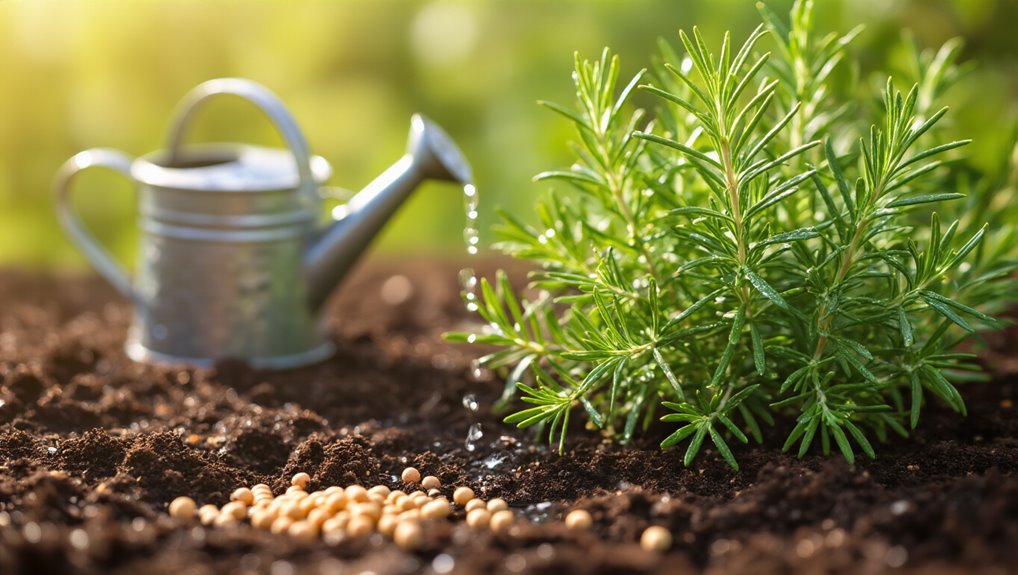
While rosemary thrives in well-drained soil and requires minimal care, understanding its watering and fertilizing needs is crucial for healthy growth.
Water your rosemary deeply but infrequently, allowing the top inch of soil to dry out between waterings. Overwatering can lead to root rot, so ensure your container or garden bed has good drainage. Many gardeners rely on essential watering cans to provide gentle, even moisture to their rosemary plants without disturbing the soil.
Fertilize sparingly; rosemary doesn’t need much. Use a balanced, water-soluble fertilizer diluted to half strength once in the spring and again in mid-summer.
If your plant shows signs of slow growth or pale leaves, it might benefit from a light feeding. Remember, a little goes a long way with rosemary, so don’t overdo it, and your plant will thrive beautifully in your garden.
For best results, consider nourishing your rosemary with the best plant food options specifically formulated for herbs, as this can support healthy, robust growth.
Pruning and Maintenance Techniques
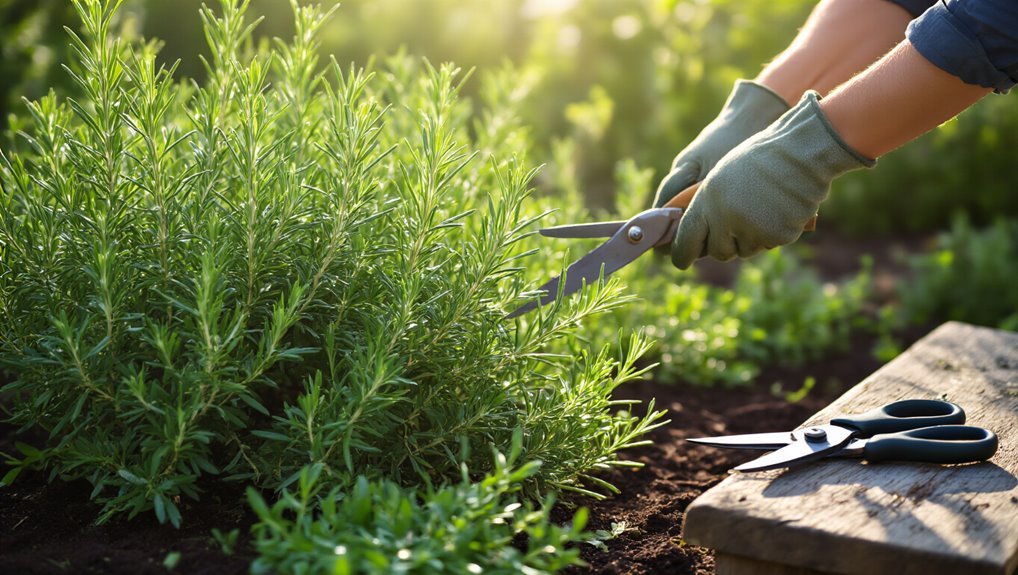
After ensuring your rosemary gets the right amount of water and nutrients, proper pruning and maintenance will keep it healthy and encourage robust growth. If you’re new to gardening, investing in essential gardening tool sets can make pruning and general care much easier.
Regularly trimming your rosemary not only shapes the plant but also promotes bushier foliage. Here are some essential techniques to follow:
- Prune in Spring: Cut back about a third of the plant to stimulate new growth.
- Remove Dead Leaves: Clear away any dead or yellowing leaves to maintain plant vigor.
- Shape the Plant: Trim to achieve a rounded or upright shape, depending on your preference.
- Monitor Growth: Keep an eye on its size and adjust pruning frequency as needed.
For best results, use pruning shears designed for gardening to make clean, precise cuts that help your rosemary thrive.
With these techniques, you’ll ensure your rosemary thrives beautifully in your garden!
Pest and Disease Management
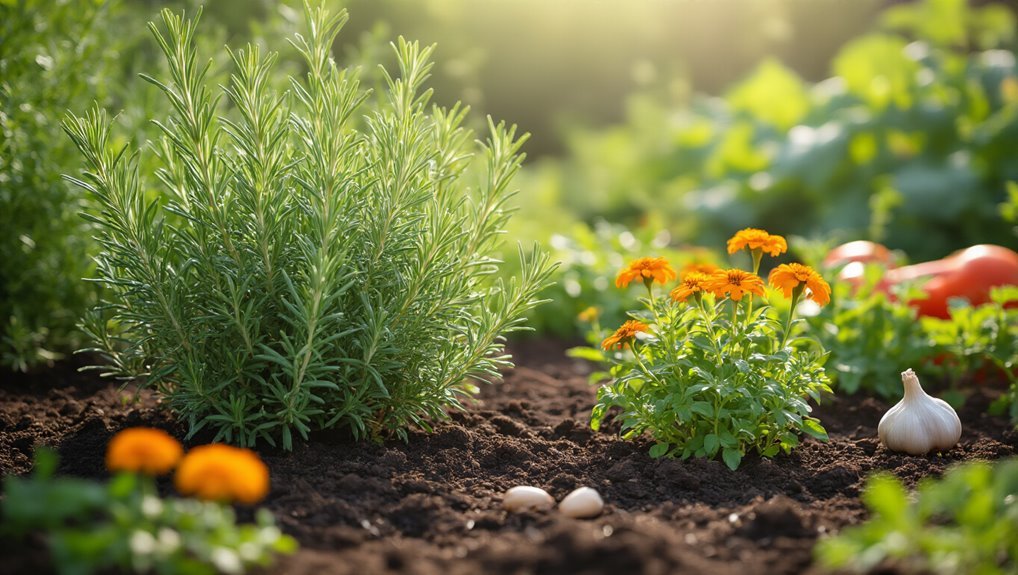
To keep your rosemary healthy, it’s crucial to manage pests and diseases proactively. Regularly inspect your plants for signs of common pests like aphids, spider mites, and whiteflies. If you notice any, use insecticidal soap or neem oil to treat the infestation. Additionally, watch for diseases such as root rot and powdery mildew, which can arise from overwatering or poor air circulation. Ensure your rosemary has well-draining soil and adequate spacing for airflow. For more information on effective solutions for pest control products, you can explore a range of options tailored for various garden needs. Using organic pest control solutions can help protect your garden while maintaining an environmentally friendly approach.
Here’s a quick reference table for pests and diseases:
| Pest/Disease | Symptoms | Treatment |
|---|---|---|
| Aphids | Curling leaves | Insecticidal soap |
| Spider Mites | Yellow spots, webbing | Neem oil |
| Root Rot | Wilting, yellowing | Improve drainage |
| Powdery Mildew | White powdery spots | Fungicidal spray |
| Whiteflies | Sticky residue, sooty mold | Insecticidal soap |
Harvesting Rosemary for Culinary Use
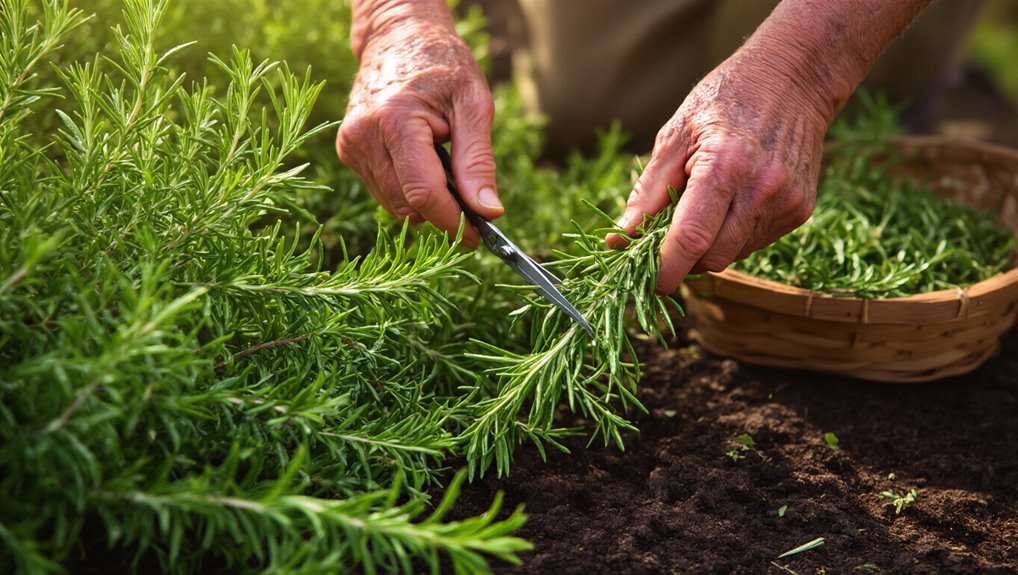
Harvesting rosemary is a rewarding experience, especially when you can enhance your culinary creations with its aromatic flavor.
To get the most out of your rosemary, follow these simple steps:
- Choose the Right Time: Harvest in the morning when the oils are most concentrated.
- Use Clean Tools: Snip branches with clean shears to prevent any disease.
- Select Healthy Stems: Look for firm, green stems; avoid any that are brown or wilted. Many gardeners find that learning from gardening books can help identify the healthiest parts of your rosemary plant.
- Don’t Overharvest: Take only what you need, leaving enough for the plant to thrive.
For even better results, consider growing your rosemary in grow bags, which can improve root health and drainage in your garden.
Winter Care and Preservation Methods
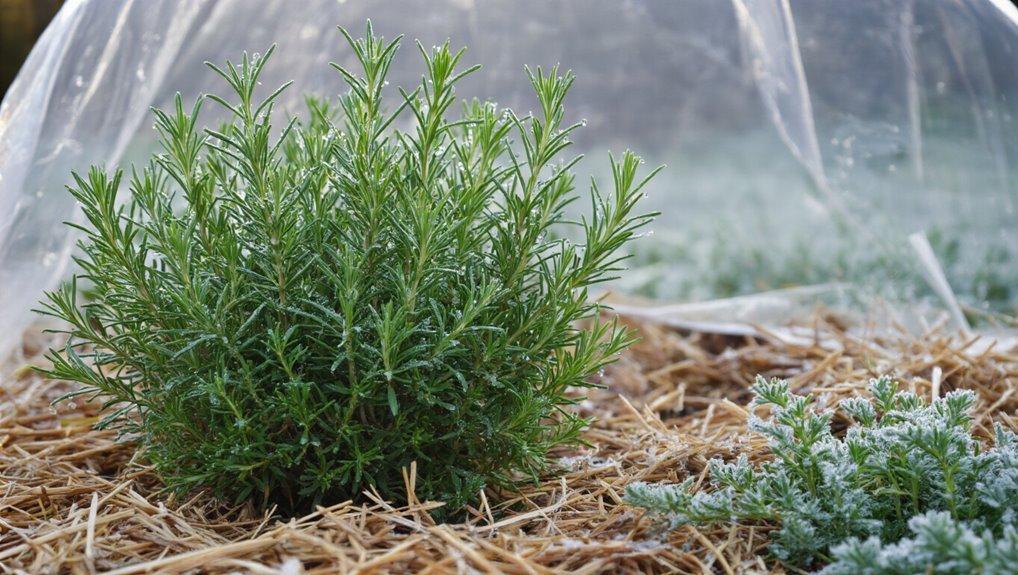
As winter approaches, ensuring your rosemary plants survive the colder months becomes crucial. To protect them, consider these winter care tips:
| Method | Description |
|---|---|
| Mulching | Apply a layer of mulch to retain moisture. |
| Watering | Water sparingly to prevent root rot. |
| Indoor Transfer | Bring potted plants indoors for warmth. |
| Covering | Use frost cloths on particularly cold nights. |
| Pruning | Trim dead or damaged branches before winter. |
Frequently Asked Questions
Can Rosemary Be Grown Indoors Successfully?
Yes, you can grow rosemary indoors successfully! Just ensure it gets plenty of sunlight, use well-draining soil, and water it when the top inch dries out. With care, it’ll thrive in your home.
What Companion Plants Work Well With Rosemary?
When pairing plants with rosemary, consider companions like lavender, sage, and thyme. They share similar water and sunlight needs, enhancing both growth and flavor. Avoid planting with basil or cilantro, as they can compete for resources.
How Long Does Rosemary Take to Grow?
So you think rosemary’s a speedy sprinter? Not quite! It usually takes about 2 to 3 weeks for seeds to germinate. If you’re starting with cuttings, you’ll see roots in about 2 to 4 weeks.
Is Rosemary Safe for Pets?
Yes, rosemary is generally safe for pets in small amounts. However, if your pet consumes large quantities, it might experience digestive issues. Always monitor their behavior and consult your vet if you notice any unusual symptoms.
Can Rosemary Survive Extreme Heat Conditions?
Yes, rosemary can survive extreme heat conditions, but it thrives with proper care. Make sure you provide adequate water and consider some shade during peak sun hours to help it stay healthy and resilient.
Conclusion
So, you thought growing rosemary would be a challenge? Surprise! With the right variety, ideal conditions, and a bit of care, you’ll find it’s as easy as pie – or should I say, as easy as seasoning that pie with fresh rosemary? Just remember, while your neighbors are struggling with their finicky plants, you’ll be snipping sprigs for your culinary creations. Enjoy your newfound gardening prowess, and don’t forget to share your secret with those still battling their brown thumbs!
